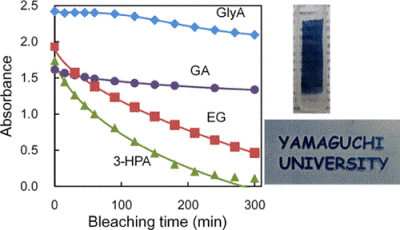論文がアクセプトされました(山崎先生・谷先生・本多先生 共著)
Effect of Dispersants on Photochromic Behavior of Tungsten Oxide Nanoparticles
in Methylcellulose
S. Yamazaki, D. Shimizu, S. Tani, K. Honda, M. Sumimoto, K. Komaguchi
ACS Appl. Mater. Interfaces, 2018, 10, 19889-19896.
DOI: 10.1021/acsami.8b04875
Abstract: Tungsten oxide-based photochromic films that change reversibly in air
between colorless-transparent in the dark and dark blue under UV irradiation
were prepared by using methylcellulose as a film matrix and various dispersants.
Alpha-hydroxyl acid such as glycolic acid (GA) or glyceric acid (GlyA)
is the best dispersant because it can make the film transparent by adding
a small quantity much less than that of 3-hydroxypropionic acid or ethylene
glycol. Fourier-transform infrared spectra and Raman spectra indicate that
a strong interaction exists between WO3 and GA or GlyA. The coloration
and bleaching processes of the prepared films were investigated to clarify
the effect of the dispersants and the moisture contents. The bleaching
rate remarkably decreased in the films containing GA or GlyA but accelerated
by increasing the contact with O2. Measurements of electron-spin resonance
reveals that GA and GlyA as dispersants stabilize the W5+ state. This paper
shows that the coloring rate and the period for keeping the blue-colored
state are tunable by changing the dispersants. The photochromic films containing
α-hydroxyl acid as the dispersant have the potential for application as
rewritable film on which information displayed with blue-colored state
can be clearly readable for longer times compared with other dispersants.
